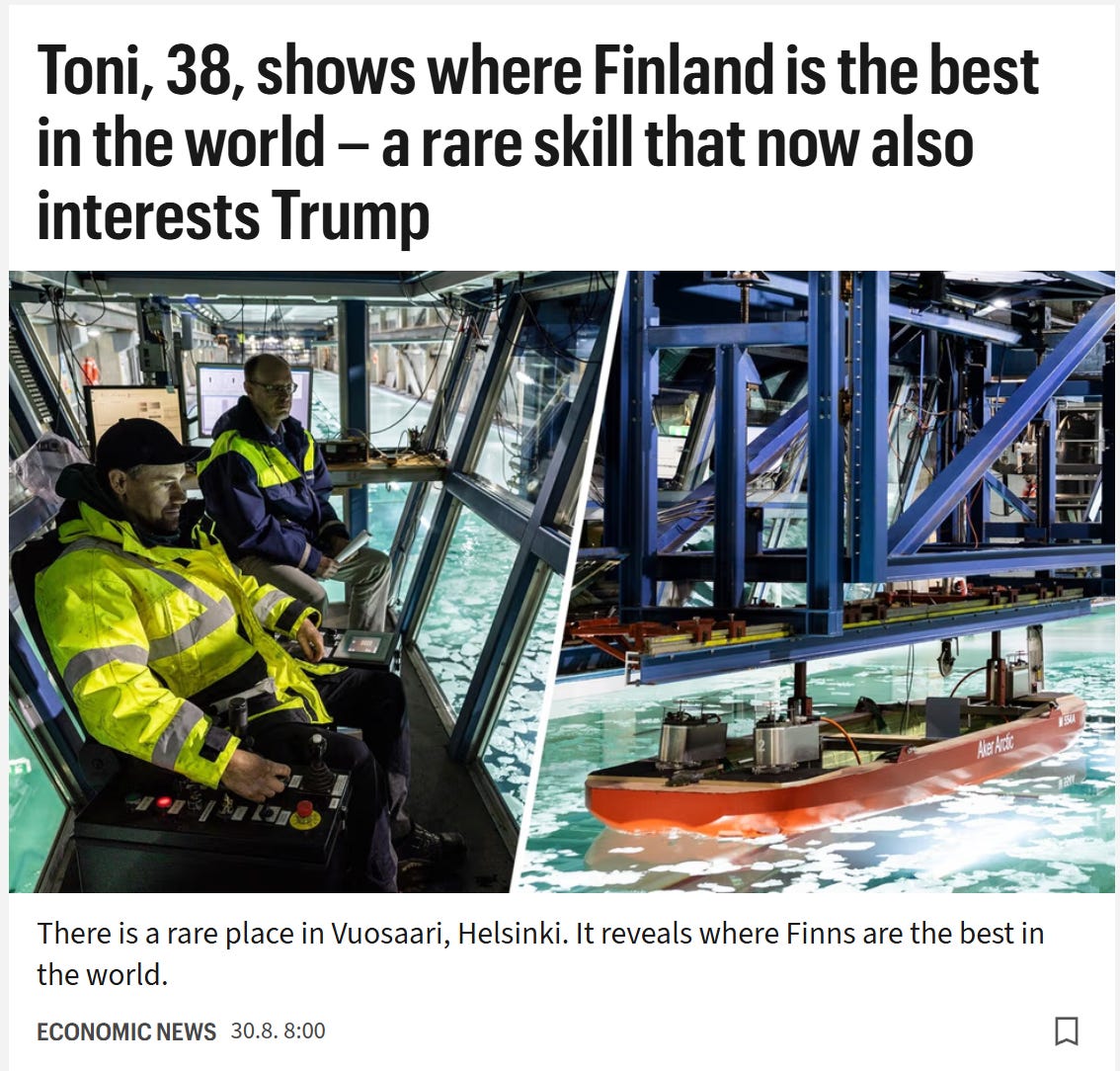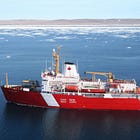Sixty Degrees North in Print (in Finnish)
I was interviewed by the Finnish Newspaper Ilta Sanomat for a recently published article on Finland's icebreaker building capability.
Last Saturday, the Finnish newspaper Ilta Sanomat (Evening News) published an article by Mikko Marttinen based primarily on his visit to Aker Arctic, the Finnish company known for its world-class design of icebreakers. If you’re interested in learning about this company—including what it takes to perform tests in their ice tank—the article is definitely worth a read. (It’s in Finnish, but mechanical translators seem to do a good job with it.)
I spent about 40-50 minutes talking with the reporter, as he also wanted an outside perspective on the Finnish icebreaker industry.
We discussed how China’s operations this summer near Alaska show the importance of U.S. Coast Guard icebreaking:
(all quotes here are mechanical translations edited by me for clarity)
Peter Rybski, the former Naval Attaché at the U.S. Embassy in Helsinki , is currently spending his retirement in Finland. In his opinion, information about China's actions on the outskirts of Alaska shows how great the need for new icebreakers is for the United States.
"You can't keep an airplane there to monitor 24 hours a day, in the same way that you could with an icebreaker," Rybski says.
He asked whether I believed that Finland deserves its reputation when it comes to building icebreakers:
The United States' own icebreaker project has progressed embarrassingly. According to the agreement signed in 2019, the shipyard in Mississippi should have delivered the finished ship to the Coast Guard in 2024, but it is currently estimated to be completed in 2030. The budget has exploded out of control.
In Finland, such problems would hardly arise. Peter Rybski agrees with the assessments of Finland as a superpower of icebreakers.
"Finland has a proven track record of designing and building icebreakers for use around the world," Rybski says.
And he asked me what I thought of the two proposals involving Finnish shipyards to build icebreakers for the U.S. Coast Guard:
Aker Arctic is part of the consortium, which also includes the Canadian shipbuilder Seaspan, the US shipyard Bollinger and the Rauma shipyard RMC.
The consortium will offer the United States the same icebreaker model that Aker Arctic has designed for the Canadian Coast Guard. The first two vessels would be built in Rauma, after which work would continue at the Bollinger shipyard in the United States.
Canadian shipbuilder Davie recently published his own proposal. The icebreaker of its own design would be built at the Helsinki shipyard owned by Davie. According to the proposal, the first icebreaker would be ready up to 26 months after the contract was signed.
According to Rybski, the proposal of Davie and the Helsinki shipyard would seem to be better suited to the needs of the US Coast Guard. It includes, among other things, weapons systems that are missing from RMC's proposal.
"U.S. Coast Guard vessels are usually armed, and this proposal also includes weapons. It also has the power and space to later add weapon systems," Rybski says.
In addition, the icebreaker proposed by Davie has more power than the vessel designed by Aker Arctic. Rybski thinks it is better suited for Arctic missions, regardless of the season.
There is much more in the IS article. It is worth a read especially for those of you interested in how these ships are designed and tested.
The Aker/Seaspan/Bollinger/Rauma consortium is offering Seaspan’s Multi-Purpose Icebreaker. I wrote about that design in this article:
Davie/Helsinki Shipyard is offering their own design, done specifically for the U.S. Coast Guard. I wrote about that design in this article:
Thoughts and Comments
I enjoyed talking with Mikko. He asked good questions and followed up to make sure that he understood my points.
At this point it is worth mentioning that my view on arming icebreakers has changed over the past year. Initially, I thought that weapons systems were not necessary, as the icebreakers of other nations are typically either not armed or only lightly armed. It is not likely that we will see these slow-moving vessels slugging it out in the ice pack anytime soon. Especially if the enemy is able to employ modern submarines against them.
However, the U.S. Coast Guard will play a role in any war with China. For that reason alone, every manned ship delivered to the U.S. Navy or U.S. Coast Guard from here forward must have a robust self-defense system and the capability to launch missiles (for either self-defense or strike missions) from VLS cells. If the ships don’t have a Mk 41 VLS installed, they must have the ability to support the Mk70 containerized system.
I plan on writing a full article about this in the near future. Stay tuned.
More coming soon. Be sure to subscribe so you don’t miss anything.
All the Best,
PGR






I first saw the image of the MPI which Seaspan is proposing for the CG ASC program a month or so ago. My first reaction was “where is the gun?” And my second reaction was that it looks a little too much like a large buoy tender rather than something that would be involved in Arctic security work. I suppose that’s because one of its multipurpose roles is to service ATON. I don’t believe that will be one of the ASC’s roles. The MPPS proposed by Davie is more what I envision when I think Arctic Security Cutter. Hope it comes to something. I’ll make suggestions from my end as I can. The Commandant does accept my emails, but that doesn’t mean he accords them much weight. But you never know. Hear it from enough different directions and it just might get some attention.
Great interview. Informative. Thoughtful. Insightful.
Finland as “Icebreaker Superpower.” Catchy…. While US shipbuilding is weak in general, and moribund for specialized missions.